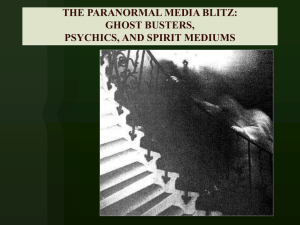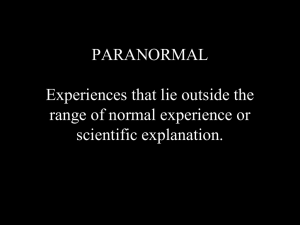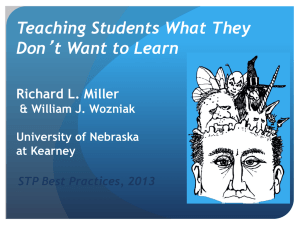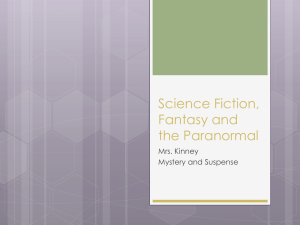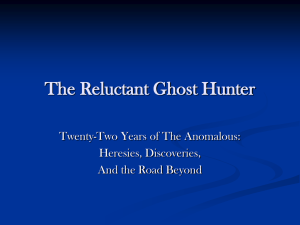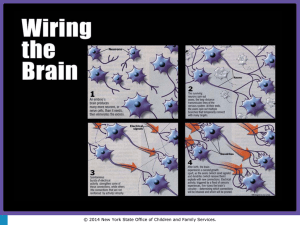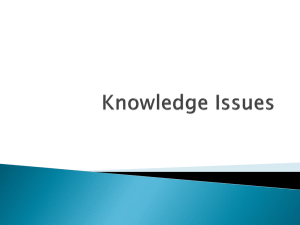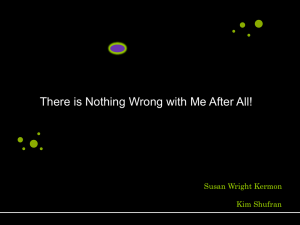Chapter 10 DD and the paranormal
advertisement
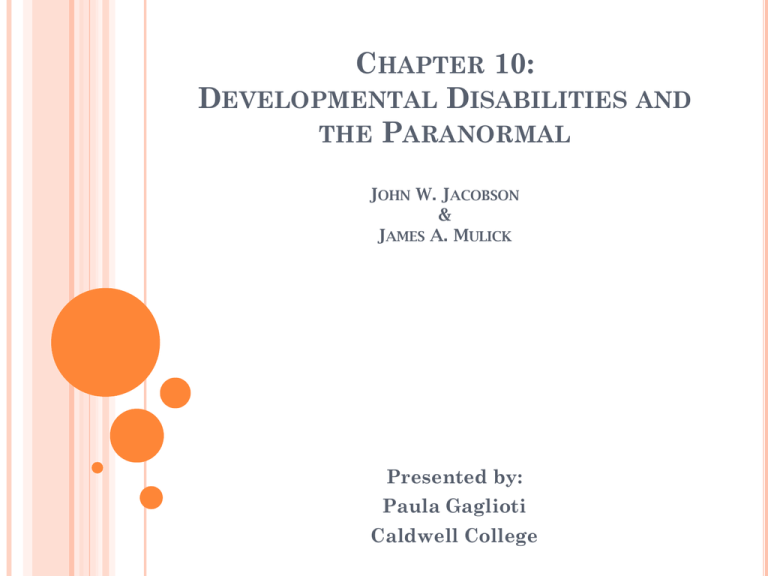
CHAPTER 10: DEVELOPMENTAL DISABILITIES AND THE PARANORMAL JOHN W. JACOBSON & JAMES A. MULICK Presented by: Paula Gaglioti Caldwell College AUTHORS John W. Jacobson: 1949-2004. Was a fellow of the American Psychological Association’s Divisions 25 (Behavior Analysis), 33 (Mental Retardation and Developmental Disabilities). He was also a member of the American Association on Mental Retardation, and the International Association for the Scientific Study of Intellectual Disabilities. BCBA “an outspoken advocate for evidence-based practice” AUTHORS James A. Mulick: child psychologist at Columbus Children’s Hospital, in Columbus OH. Also a professor at Ohio State University. Published articles in journals such as: Psychology in Mental Retardation and Developmental Disabilities, Behavioral Interventions and Journal of Child and Family Studies. THE PARANORMAL 90% of Americans believe in one or more supernatural or paranormal phenomena. It is culturally typical in society to hold at least some belief in the supernatural or paranormal. Women are more likely to report supernatural or paranormal experiences then men. However, no scientific support for the existence of paranormal phenomena. YET THERE ARE STILL BELIEVERS! Existence of paranormal phenomena is a matter of pure faith. Differentiation between faith in everyday life and the paranormal. This separation is provided by psychologists and sociologists. 1) Religiosity 2) Spirituality 3) Spiritualism 4) Faith in paranormal or psi RELIGIOSITY Engaging in prayer Attending religious services Practicing certain rituals Accepting certain doctrines Retelling certain stories SPIRITUALITY & SPIRITUALISM Spirituality: Belief in a divine entity Spiritualism: Belief in spirits, contacting the deceased through mediums and séances, and psychic healing. Some aspects of spiritualism consistent with some aspects of paranormal. Belief in undetected and unmeasured field energy within or about the human body Telepathy: knowledge of others’ thoughts Clairvoyance: visualization of objects of events not within physical view Psychokinesis: ability to move objects through exertion of will SPIRITUALISM VS. PARANORMAL Spiritualism implies a religious component to beliefs which may or may not be consistent with traditional organized religious faiths. Paranormal beliefs may or may not be rationalized or characterized on the basis of individual religious faith. FAITH Mere belief or trust in some agency or source of information. We act on this form of faith in everyday tasks. We trust the people who inform us, thus we take certain action which leads to a certain outcome and we perform accordingly. Gather information from: family members, authority figures, newspaper, television, peers etc.. FAITH CONT’D Trust, belief and faith form intricate mutually reinforcing systems of guidelines, some in the form of laws and rules and some in unspoken patterns of compliance. Matters of faith affect our decision making Our ability to follow advice and rules that we are given or that we construct ourselves from the basis of learning from our own experiences with other people and information. FAITH IN CONVENTIONAL RELIGION & DISABILITY Parents of children with autism or mental retardation find hope and comfort in their religion. “In despair we and others sought God to remove the Down syndrome from him. We will pray for this all our remaining days, or until God or one of His disciples brings forth Jacob’s healing, or until Jacob tells us to stop. We also sought out, through the internet, other parents of Down syndrome (DS) to pray with us, but instead found a lot of Christians who believed God had put this on their children and that we need to embrace DS as our friend” (Cardon Household, 2002, p.1) FAITH, DISABILITY & THE INTERNET Internet reports many cases of miraculous cures and substantial benefits from conventional medical or health intervention. Internet also lists evidence between paranormal phenomena and developmental disability. In 1993, a series of messages exchanged on group.bit.listserv.autism contained this statement “Believing that telepathy comes from God isn’t knew either. I think so – but you don’t have to think anything at all about God to believe in telepathy. The link between autistic children and their parents…is extraordinary, we all know that. So I have no trouble believing in telepathic aspect of autism” FAITH, DISABILITY & THE INTERNET CONT’D In 1996, messages on alt.paranormal and bit.listsev.tbi-support wrote “that traumatic brain injury frees up or releases paranormal powers” In 1999, a discussion on bit.list.seve.autism included the use of astrology (which is a spiritualistic practice) as a basis for predicting, prenatally, that a child will have autism or mental retardation. RESEARCH ON THE PARANORMAL Mixed reviews: Milton and Wiseman (2001) claimed to show substantial evidence in paranormal abilities by use of the Ganzfeld Apparatus. Ganzfeld apparatus – insert one’s head into the apparatus which presents a featureless visual field with rounded surfaces all at equal distances from one’s eye. Musch and Ehrenberg (2002), believers [in the paranormal] were more likely to underestimate the likelihood of coincidental or chance events compared to non believers. SO?! To summarize thus far: belief in paranormal phenomena remains very difficult to predict on the individual level. However we can say that there is a general tendency to believe in things. THE PARANORMAL & DEVELOPMENTAL DISABILITIES Autism and the Paranormal Telepathy “common ability in autistic individuals” (Georgiana Institute, 2002) “noted in specific instances to occur in children with autism” (Auerbach, 1994; B.A. Bear Autism Foundation, 2002). Savant Syndrome “refers to presence of remarkable, usually very specific skills among people with intellectual disability and often both intellectual disability and autism. These skills commonly entail drawing, musical performance or arithmetic feats” (Down, 1887) http://www.youtube.com/watch?v=OR36jrx_L44 THE PARANORMAL & DEVELOPMENTAL DISABILITIES Facilitated Communication a technique by which a “facilitator” provides physical and other supports in an attempt to assist a person with a significant communication disability to point to pictures, objects, printed letters and words, or to a keyboard. “Link” between facilitated communication and telepathy. “shortly after facilitation begins, and the initial concerns have been dealt with, facilitators often report that their communicators have an uncanny ability to know thoughts in their facilitators’ minds. Exploration usually revels that communicators have a well developed ‘sixth sense’ that allows them to understand that other think, feel or know” (Hanskew & Donnellan, 1992). FACILITATED COMMUNICATION CONT’D James Randi (Correx Archive, 2002) who is a well known debunker of spiritualistic phenomena… Unable to verify the authenticity if communication via FC. Unable to verify telepathy as an element of FC activity. In a specific case he worked on with an individual with autism reported all evidence of a link between FC and telepathy was anecdotal. http://www.youtube.com/watch?v=CzYIidZvfjA THE PARANORMAL & DEVELOPMENTAL DISABILITIES Complementary and alternative medicine (CAM) Large market and sale of complementary and alternative therapies, some of which are completely founded on paranormal premises. Stevens (2001) noted that “the acceptance of many methods of complementary and alternative healing (e.g. homeopathy) involves magical thinking, which is not based on proof of cause and effect, but rather on perception and subsequent stipulation of assumed cause and effect”. In fact paranormal based therapies are marketed directly for people with developmental disabilities! HERE’S AN EXAMPLE… Lawton (2002) reported: “an extremely important way that some naturopathic physicians can benefit the autistic patient is with constitutional homeopathy. Constitutional homeopathy (treating the entire person rather than the particular symptoms) can also result in significant behavior improvement and in some case there may be complete cessation of the autistic behavior” THE PARANORMAL & DEVELOPMENTAL DISABILITIES Energy-based therapies: “therapy which invokes the cosmic energy from the cosmos and is transmitted to a person through the channel of an accomplished healer. This actuates overall healing of the person, apart from his/her specific short-term or chronic disease” (Devi, 2002). ENERGY BASED THERAPIES These included: Thought field therapy (TFT): “used when imbalances in the bodies ‘sic’ energy which causes negative emotions” (Alataffer, 2002). Bi-aura therapy: linking “physical health to energy blockages” (Loch Ness, 2002). Cranio-sacral therapy: used to “keep alive the fluctuating field of energy known as the ‘spirit’ , which is separate and not controlled by the body’s nervous system” (Dea, 2002). Magnetic field therapy: “deprivation of the influence of the ‘natural’ magnetic field affects bioelectric cellular equilibrium” (Sabadell, 1998). Therapeutic touch (TT): “practitioner scans the patient’s energy field pattern using the hands as sensors… The practitioner is able to assess the patient’s energy by feeling various sensations given from the patient (tingling, heat, cold, heaviness, a drawing field) (Starr et al., 2000). http://www.youtube.com/watch?v=DAZygugGoek CONCLUSIONS There is no evidence that alternative therapies based on spiritualistic or paranormal premises are of any benefit in the treatment for people with developmental disabilities. Reviews available on the Internet on these “therapies” that they work! Use vague or emotional language which “pull” the parents in. We need to advise parents as professionals upon hearing about these miraculous therapies that data and substantial research should support their claims. CONCLUSIONS Parents need to be aware that these alternative therapies may conflict with therapies that do have sound basis, which may postpone results. Become aware of Pratkanis study (2000) which researched the use of propaganda techniques in written strategies. Use “intensely emotionally appealing words, use vague rational, oversimplification of the issue, project negative qualities on others, anti-intellect content (i.e. saying professional is non-sympathetic), encouragement to identify with the propagandist(i.e. I’m a parent with of a disabled child) , or just lie”. FINAL THOUGHT We should consider this observation made from Carl Sagan, an astronomer, (1996): “It is barely possible that a few paranormal claims might one day be verified by solid scientific evidence. But it would foolish to accept any of them without adequate evidence”. REFERENCE Jacobson, J.W., Foxx, R.M., & Mulick, J.A. (Eds). (2005). Controversial therapies for developmental disabilities: Fad, fashion, and science in 4192-X professional practice. Hillsdale, NJ: Erlbaum, ISBN: 0-8058-
